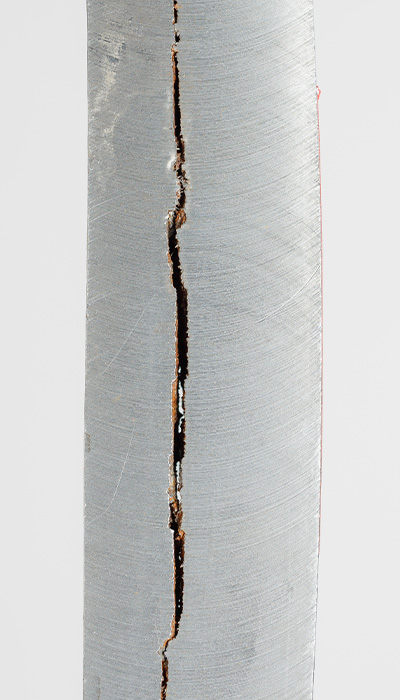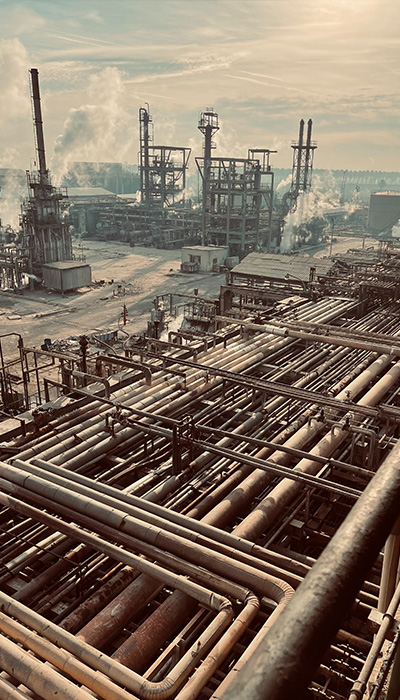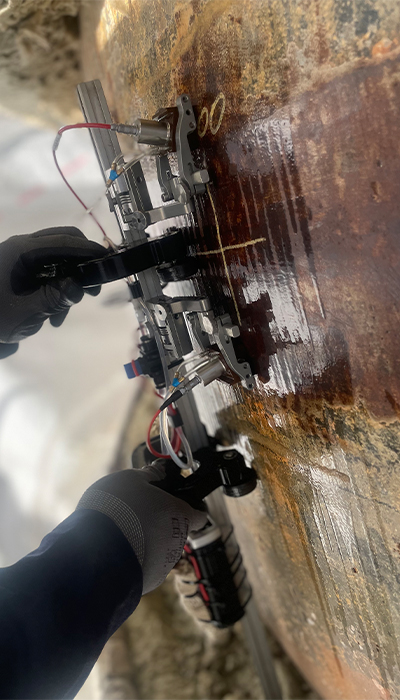The following key components can lead to HTHA:
Presence of Hydrogen
Presence of high pressure
Operating at temperatures above ~200°C
Presence of stress
Material Chemistry
Duration of exposure

The SonoInspec High Temperature Hydrogen Attack (HTHA) approach is based on HTHA susceptibility levels of your assets, Hydrogen Embrittlement, and blistering. The API941 approach will be followed. Full weld volume is inspected, including an inspection on transverse cracking.
In a number of processes when hydrogen is present occurring at high temperature and pressure, systems can be susceptible to damage caused by the phenomena called High Temperature Hydrogen Attack (HTHA). The hydrogen reacts with carbides in steel to form methane (CH4) which cannot diffuse through the steel. The decarbonisation causes an overall loss in strength. When the methane pressure builds up, microfissures can grow to the next stage of micro cracking to macro cracking. Low alloy steels are most susceptible to HTHA. The more Cr in the material, the less susceptible to HTHA.
Fill out your e-mail address and we’ll send you our brochure. And don’t worry - we hate spam too 😉
Complete approach, FFS, NDT, Replica’s etc
Approach based on susceptibility levels
High level experts available
Presence of Hydrogen
Presence of high pressure
Operating at temperatures above ~200°C
Presence of stress
Material Chemistry
Duration of exposure

Hydrogen Embrittlement
Blisters

Occurs at lower temperatures and often related to start stop cycles, where hydrogen does not diffuse completely out of the material at the stop cycles and building up its concentration, which can lead to cracking. The diffusion of hydrogen can lead in cladded pressure vessels to disbonding of the cladding.

Blisters can for example occure if there is already a crack in the weld or parent material, for example from the manufacturing phase, where two H atoms will form together an H2 molecule, which create a bubble.

The SonoInspec approach is based on API941. Susceptibility levels are taken into account for the inspection plan and the practical approach. Full weld volume is inspected, including an inspection on transverse cracking. Techniques are TOFD with in addition PAUT/Manual UT.

Backscatter technique and velocity time ratio measurements. With the backscatter technique, you will see the front of micro/macro cracking. With the velocity time ratio measurement, you will check if the index in travel time between longitudinal and transverse sound is changing, since both wave types are influenced differently by the micro/macro cracking front in the material. The SonoInspec teams are equipped with the most modern equipment. Real time Total Focussing Method (TFM) can be applied to detect and invest the smallest indications found. Together with a specialised partner SonoInspec can also provide replica’s and boat samples when required.

SonoInspec, together with Sintra Engineers can deliver a full FFS assessment. The FFS assessment is strongly dependent on the mechanical design, type of damage mechanism, material construction, location of damage, operating conditions etc.. We can support our clients in scope determination based on susceptibility levels and reduce the risk for extension of the turnaround (TA), by calculating the minimum allowable defect size for wall loss and crack like flaws in advance as per API579. Remaining life assessment calculations for crack like flaws can be delivered. This can be done by crack growth analysis. The feasibility of this, is strongly depending on the damage mechanisms acting in the vessel/component.
Fill out your e-mail address and we’ll send you our brochure. And don’t worry - we hate spam too 😉
We’re happy to help you! Feel free to fill out our contact form and we’ll get back to you as soon as possible!
Are you also doing Hydrogen Induced Cracking Inspections (HIC)?
Yes, we also do HIC inspections. For this, we can apply one of the corrosion mapping techniques, TOFD line scans or PAUT line scans with TFM for additional inspections.
Where can you deliver the HTHA inspections?
We can deliver these inspections all over the globe. Our clients are based in India, Pakistan, the Middle East, South America, Europe.
just scan the QR code with your phone
or enter our number manually:
+31 6 246 177 55